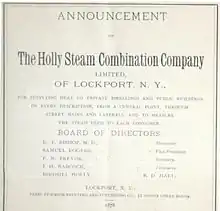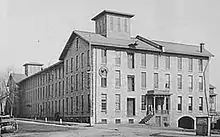Holly Steam Combination Company
The Holly Steam Combination Company was an American company that was the first steam heating producer to commercially distribute district heating from a central steam heating system. The company was established in 1877 by engineer Birdsill Holly when he formed a central steam heating system to heat multiple surrounding buildings in an immediate city area.

The company was reorganized in 1882 to become the American District Steam Company (ADSC). It did research and development on central station heating systems and franchised municipal steam heat districts to cities. ADSC developed into the largest and most important company in the United States for the distribution and sale of heat and power from steam.
History


Birdsill Holly, mechanical engineer and inventor of water hydraulics devices, began working on a district steam system using a central boiler system in 1876 in Lockport, New York.[1] He was well known as an inventor and used his reputation to try to attract investors to develop out a steam heating technology, but failed. He was confident in his concepts of this, so used his own money to experiment with. He began by constructing a 700 foot (210 m) underground line of half inch (1.3 cm) insulated wooden piping across his property. The pipe was laid from his barn 3.5 feet (1.1 m) below the ground to his farmhouse. He used a boiler to heat up water to produce steam. The steam from the boiler was pumped through the pipes and collected at a mechanical distributor device in the attic of his house. From there the steam went to various heating coils. The used steam then was sent back to the boiler by return piping and reheated to be used again.[1][2]
Holly then connected an adjoining house making his first "district" consisting of a barn and a neighbor's house after successfully achieving the transfer of heat at his own property using steam distribution. The following year he constructed an experimental central steam heating plant in Lockport. The system of three miles (4.8 km) of supply and return pipes were on Locust, Genesee, and Walnut Streets.[3] They sent heat to several surrounding homes, stores and office buildings.[4] This heating system had a method of using energy efficiently and was better than individual boilers then in use to heat a building. This new technology attracted the attention of certain investors that were willing to take the risk of developing it.[5] Holly, with these investors, then formed the Holly Steam Combination Company in 1877 with a capital stock of $25,000.[6] It was the first central station for district heating using steam.[7][8][9]
The company bought out the patents that Holly had on this steam heating system. The company then established franchises for heating plants in cities and towns across the United States. The marketing plan was for a sales representative of the company to visit a certain town or city and to present the system to town merchants and bankers. If they wanted the system, a city municipal subsidiary would then be formed and bonds sold to the residents. From the money generated, steam generating boilers and pipe-line systems would be installed to heat the downtown buildings.[4][5]
The Holly heating systems first used wood insulated pipe and the steam was distributed using high duty pumping engines.[10][11] Holly continued to improve on the system and had 50 patents by 1882.[12] By 1888 he obtained over 150 patents refining steam heat techniques and methods of distribution.[10] In the 1880s Holly had installed some three dozen city district steam systems in the United States and Canada. Some of these cities were Chicago, Brooklyn, New York, Buffalo, St. Louis, Cleveland, Detroit, Toronto and Montreal. He also installed his heating systems in factories, orphanages, asylums, and universities.[13] The first electric company to become interested in his system was the Brush Swan Electric Light Company of Auburn, New York, which in 1885 put one in operation.[14] By 1894 the Holly steam systems had been installed in more than 2000 towns and cities throughout the United States and Canada.[15]

North Tonawanda, New York
Demise
The Holly Steam Combination Company was reorganized in 1882 and became the American District Steam Company (ADSC). This new company bought out the patent rights of the Holly Company and Holly's additional inventions he had recently made in the previous five years. The company, besides franchising municipal steam heat districts, did research and development on central station heating systems. New York City obtained a franchise contract from ADSC for the New York Steam Company, which developed into the largest and most important company in the United States for the distribution and sale of heat and power from steam.[5]
References
- Bushnell 1915, p. 2.
- Marie Linnabery, Ann (January 6, 2018). "Niagara Discoveries-Holly Steam Combination Company". Lockport Union-Sun & Journal. Retrieved August 22, 2020.
- Hinds 2012, p. 37.
- Bushnell 1915, p. 3.
- Hart, Marion (2012). "Birdsill Holly, Jr". ASME. The American Society of Mechanical Engineers. Retrieved December 30, 2015.
- "The Holly Manufacturing Company 1858–1916". Holly Manufacturing Company History. Lockport Cave & Underground Boat Ride. 2015. Retrieved December 30, 2015.
- Kane 1997, p. 94.
- Brownlie 1941, p. 183.
- Jeans 1928, p. 377.
- "Birdsill Holly 1820–1894". Holly Manufacturing Company History. Lockport Cave & Underground Boat Ride. Retrieved December 30, 2015.
- Hawkins 1902, p. 245.
- "Birdsill Holly". Anglefire. 2015. Retrieved December 30, 2015.
- McGreevy 2009, p. 206.
- Bushnell 1915, p. 4.
- "Birdsill Holly dead". Buffalo Evening News. Akron, Ohio. April 28, 1894. p. 13 – via Newspapers.com
 .
.
Sources
- Brownlie, David (July 1941). Engineering. Design Council.
District heating was made a commercial success in 1877 at his house in Chestnut-avenue, Lockport, New York, by Birdsill Holly, who founded the first steam heating company, known as the Holly Steam Combination Company.
- Bushnell, S. Morgan (1915). District Heating: A Brief Exposition of the Development of District Heating and Its Position Among Public Utilities. Heating and Ventilating Magazine Company. p. 3.
- Hawkins, Nehemiah (1902). New Catechism of the Steam Engine: With Chapters on Gas, Oil and Hot Air Engines. T. Audel.
- Hinds, Conrade C. (2012). The Great Columbus Experiment of 1908: Waterworks that Changed the World. The History Press. ISBN 978-1-60949-779-8.
- Jeans, James Hopwood (1928). The Physics of the Universe. R. & R. Clark, limited.
District heating was made a commercial success in 1877, at his house in Chestnut Avenue, Lockport, New York, by Birdsill Holly, who founded the first steam heating company, known as the Holly Steam Combination.
- Kane, Joseph Nathan (1997). Famous First Facts, Fifth Edition. item 2078: The H. W. Wilson Company. ISBN 0-8242-0930-3.
The first heating system to heat buildings from a central station was installed in Lockport, NY, in 1877 by Birdsall Holly. He ran a steam line through a trench for a distance of 100 feet from his house to an adjoining property and found that the heat was not lost by being carried through pipes. He subsequently formed the Holly Steam Combination Company, whose first plant was located at Elm and South streets, Lockport. The company was later operated by the New York State Electric and Gas Corporation, Lockport division.
CS1 maint: location (link) - McGreevy, Patrick (9 April 2009). Stairway to Empire: Lockport, The Erie Canal, and The Shaping of America. SUNY Press. ISBN 978-1-4384-2527-6.